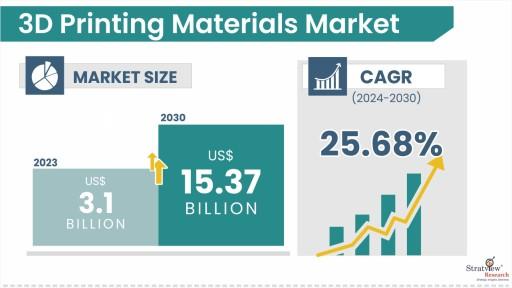Key Trends Shaping the 3D Printing Materials Market

Introduction:
The 3D printing materials market has seen remarkable growth over the past decade, driven by innovations in additive manufacturing and the increasing demand for customized products across industries. These materials, ranging from plastics and metals to ceramics and composites, have become indispensable in sectors like aerospace, automotive, healthcare, and consumer goods.
The 3D Printing Materials Market was estimated at US$ 3.1 billion in 2023 and is expected to grow at an impressive CAGR of 25.68% during 2024-2030 to reach US$ 15.37 billion by 2030.
Key Drivers:
-
Technological Advancements in 3D Printing: The continuous improvement in 3D printing technologies, including advancements in printer resolution, speed, and scalability, is directly influencing the demand for high-quality, specialized materials. As printers become more sophisticated, the need for a wider variety of materials, capable of delivering different properties, is growing.
-
Customization and Complex Designs: One of the main advantages of 3D printing is its ability to create highly customized and complex structures that traditional manufacturing methods cannot achieve. Industries such as healthcare and automotive, where customized parts are crucial, are driving the demand for specialized 3D printing materials like biocompatible polymers and lightweight metal alloys.
-
Sustainability Trends: With an increasing emphasis on sustainability and reducing waste in manufacturing processes, 3D printing is viewed as a more eco-friendly option. Additive manufacturing allows for precise material use, minimizing waste generation. The growing demand for recyclable and biodegradable 3D printing materials, such as plant-based plastics, further supports the market's expansion.
-
Growth in End-Use Applications: The range of applications for 3D printed parts is expanding, particularly in industries such as aerospace, where lightweight materials are critical for fuel efficiency, and in healthcare, where 3D printing is used to create personalized implants and prosthetics. The increasing use of 3D printing for rapid prototyping also plays a significant role in driving material demand.
Challenges:
-
Material Limitations: Despite the growth of the market, material limitations remain a key challenge. While a wide variety of materials are available, many are still limited in terms of strength, flexibility, and durability, especially for high-performance applications like aerospace and automotive manufacturing.
-
High Material Costs: The cost of 3D printing materials remains relatively high compared to traditional manufacturing materials. This is especially true for specialized materials like high-strength metals and composites. While costs have been decreasing over time, they still pose a barrier for widespread adoption in cost-sensitive industries.
Opportunities:
-
New Material Development: Continuous research into new 3D printing materials, including metal alloys, bio-based polymers, and high-performance ceramics, presents significant opportunities for growth. Material suppliers are increasingly focused on developing materials that offer better performance, lower cost, and improved sustainability.
-
Industry-Specific Innovations: Industries such as aerospace, healthcare, and automotive are increasingly adopting 3D printing for end-use part production. For example, in aerospace, the need for lightweight, strong materials is pushing the demand for metal and composite materials, while in healthcare, the demand for biocompatible materials for implants is on the rise.
To get free sample, Register Here: https://www.stratviewresearch.com/Request-Sample/851/3d-printing-materials-market.html#form
Conclusion:
The 3D printing materials market is expanding rapidly, driven by technological advancements, increased demand for customization, and sustainability efforts. As new materials are developed and the cost of 3D printing decreases, the market will likely continue to grow, enabling new applications across industries and transforming traditional manufacturing processes.
- Information Technology
- Office Equipment and Supplies
- Cars and Trucks
- Persons
- Books and Authors
- Tutorials
- Art
- Causes
- Crafts
- Dance
- Drinks
- Film
- Fitness
- Food
- Игры
- Gardening
- Health
- Главная
- Literature
- Music
- Networking
- Другое
- Party
- Religion
- Shopping
- Sports
- Theater
- Wellness



